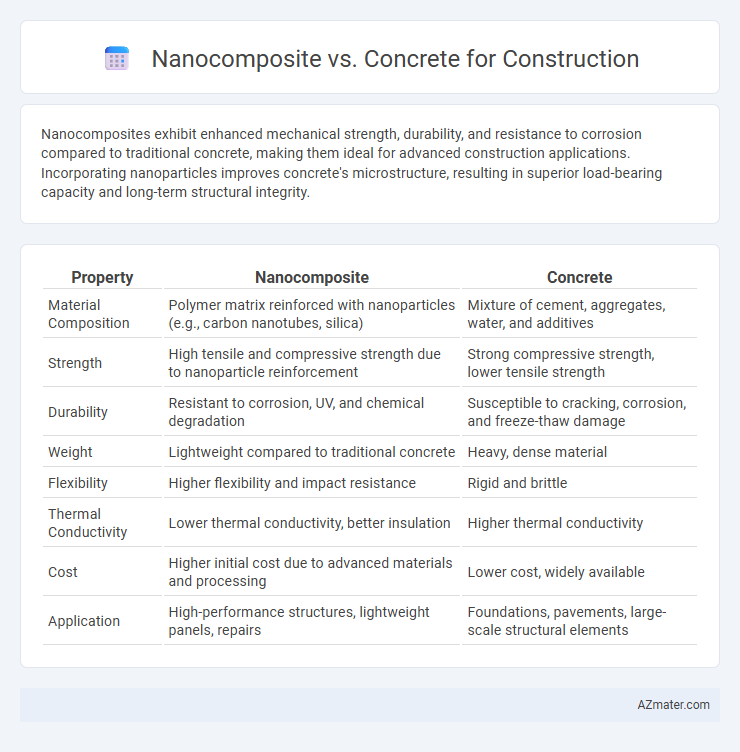Nanocomposites exhibit enhanced mechanical strength, durability, and resistance to corrosion compared to traditional concrete, making them ideal for advanced construction applications. Incorporating nanoparticles improves concrete's microstructure, resulting in superior load-bearing capacity and long-term structural integrity.
Table of Comparison
| Property | Nanocomposite | Concrete |
|---|---|---|
| Material Composition | Polymer matrix reinforced with nanoparticles (e.g., carbon nanotubes, silica) | Mixture of cement, aggregates, water, and additives |
| Strength | High tensile and compressive strength due to nanoparticle reinforcement | Strong compressive strength, lower tensile strength |
| Durability | Resistant to corrosion, UV, and chemical degradation | Susceptible to cracking, corrosion, and freeze-thaw damage |
| Weight | Lightweight compared to traditional concrete | Heavy, dense material |
| Flexibility | Higher flexibility and impact resistance | Rigid and brittle |
| Thermal Conductivity | Lower thermal conductivity, better insulation | Higher thermal conductivity |
| Cost | Higher initial cost due to advanced materials and processing | Lower cost, widely available |
| Application | High-performance structures, lightweight panels, repairs | Foundations, pavements, large-scale structural elements |
Introduction to Construction Materials
Nanocomposites incorporate nanoparticles into a matrix material to enhance mechanical, thermal, and durability properties, making them an innovative alternative in construction materials. Concrete, the traditional construction composite, consists primarily of cement, water, aggregates, and additives designed for compressive strength and longevity in structures. The integration of nanocomposites introduces improved performance characteristics such as increased strength-to-weight ratios, reduced permeability, and enhanced resistance to environmental degradation compared to conventional concrete.
Overview of Traditional Concrete
Traditional concrete, a composite material made of cement, water, sand, and gravel, provides durability and compressive strength essential for construction. Despite its widespread use, traditional concrete faces challenges such as brittleness, susceptibility to cracking, and limited tensile strength. Advances in nanocomposite technology aim to enhance these mechanical properties by incorporating nanoparticles to improve durability, flexibility, and resistance to environmental stressors.
What Are Nanocomposites?
Nanocomposites are advanced materials composed of a traditional matrix, such as cement or polymer, embedded with nanoparticles that enhance mechanical, thermal, and durability properties. In construction, these nanoparticles improve concrete's strength, reduce permeability, and increase resistance to cracks and corrosion compared to conventional concrete. The integration of nanomaterials like carbon nanotubes, nanosilica, or nanoclays transforms concrete into a more resilient and long-lasting nanocomposite.
Mechanical Strength Comparison
Nanocomposites exhibit significantly higher mechanical strength than traditional concrete due to the incorporation of nanoparticles such as carbon nanotubes or nanosilica, which enhance tensile strength, compressive strength, and durability. The nanoscale fillers improve the microstructure by reducing porosity and increasing the interfacial bonding within the cement matrix, resulting in superior fracture toughness and resistance to crack propagation. Concrete typically shows lower mechanical performance metrics, with conventional compressive strengths ranging from 20 to 40 MPa, whereas nanocomposite-based materials can exceed 60 MPa under optimized conditions.
Durability and Longevity Analysis
Nanocomposites exhibit enhanced durability and longevity compared to traditional concrete due to their improved resistance to cracking, corrosion, and environmental degradation. The incorporation of nanoparticles in nanocomposites results in a denser microstructure, reducing permeability and increasing resistance to freeze-thaw cycles and chemical attacks. Concrete, while widely used, often requires additional reinforcement and maintenance to achieve comparable long-term performance in harsh construction environments.
Environmental Impact and Sustainability
Nanocomposite materials in construction offer significant environmental benefits over traditional concrete by enhancing durability and reducing the need for frequent repairs, which lowers resource consumption and carbon emissions. The incorporation of nanoparticles improves material strength and lifespan, leading to decreased cement usage and associated CO2 emissions, contributing to more sustainable building practices. Compared to standard concrete, nanocomposites enable lightweight structures with superior thermal insulation, reducing energy demand and the overall ecological footprint of construction projects.
Cost Efficiency and Economic Considerations
Nanocomposite materials demonstrate superior cost efficiency in construction through enhanced durability and reduced maintenance expenses compared to traditional concrete. The initial higher investment in nanocomposites is offset by extended service life and lower repair frequency, resulting in favorable lifecycle economic benefits. Concrete remains economically viable for large-scale projects due to established production methods, but nanocomposites offer long-term financial advantages by minimizing structural degradation and improving performance.
Application Versatility in Construction
Nanocomposites exhibit superior application versatility in construction by offering enhanced mechanical strength, durability, and resistance to environmental factors compared to traditional concrete. Their ability to integrate nanoscale reinforcements like carbon nanotubes or silica nanoparticles results in lightweight, high-performance materials suitable for diverse structural elements, including beams, coatings, and panels. Concrete remains widely used for large-scale infrastructure due to cost-effectiveness and ease of production, but nanocomposites enable advanced applications requiring tailored properties and extended service life.
Advances in Nanocomposite Technology
Nanocomposite technology in construction offers enhanced mechanical strength, durability, and resistance to environmental degradation compared to traditional concrete. Incorporating nanoparticles such as silica, carbon nanotubes, and nanoclays into cement matrices significantly improves tensile strength, reduces porosity, and accelerates curing time. Recent advances enable tailored nanocomposite formulations that improve sustainability by lowering carbon emissions while optimizing thermal insulation and structural performance.
Future Trends in Building Materials
Nanocomposite materials exhibit superior mechanical strength, enhanced durability, and improved thermal insulation compared to traditional concrete, positioning them as a transformative solution in construction technology. Emerging trends emphasize the integration of nanomaterials like carbon nanotubes and nanosilica into cement matrices to significantly reduce carbon footprints and increase infrastructure longevity. Future building materials will increasingly rely on these nanocomposite innovations to meet sustainability goals and adapt to evolving architectural demands.

Infographic: Nanocomposite vs Concrete for Construction
 azmater.com
azmater.com